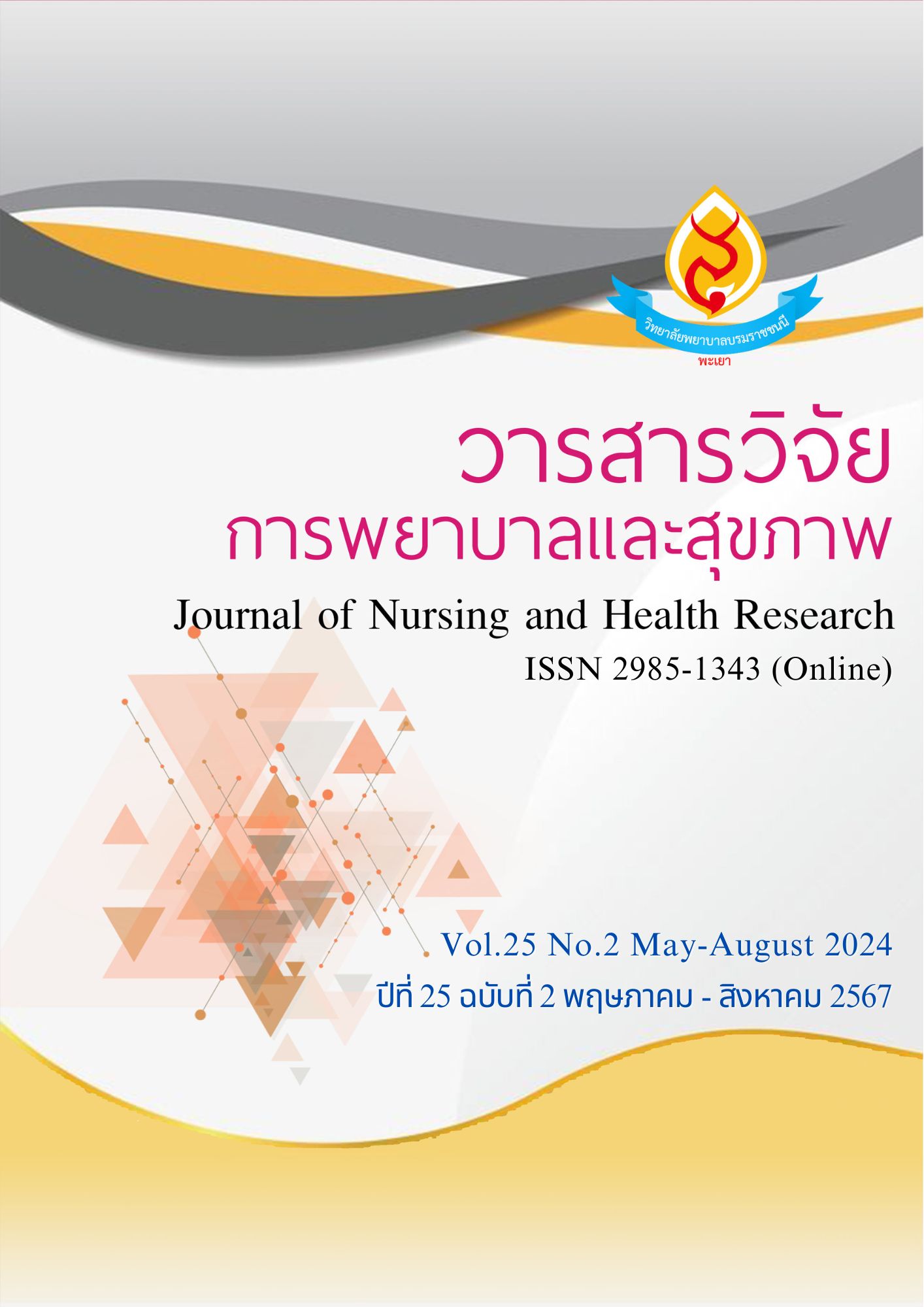Effects of a virtual reality rehabilitation program on motivation, hip function, and perceived self-efficacy among older persons undergoing hip surgery
Keywords:
Virtual reality rehabilitation program, Hip surgery, Motivation, Hip function, Perceived self-efficacyAbstract
Virtual reality technology can rehabilitate physical and cognition in older adults. This experimental research design; pretest-posttest control group design aimed to examine the effects of a virtual reality rehabilitation program on motivation, hip function, and perceived self-efficacy among older persons with post-operation of the hip. A total of 88 older adults were recruited and simple random sampling. They were allocated into the experimental and control groups by block randomization 44 each group. The instruments were the virtual reality of a rehabilitation program (VR-rehabilitation program) for the elderly with a post-operation, motivation scale, and post-operative hip self-efficacy scale (PHOSE). The scale-level content validity of all instruments was at .97-.1.00. The instruments had an acceptable reliability of .81-.97. Data were analyzed using descriptive statistics and Multivariate Analysis of Variance (One-way MANOVA). The results of this research demonstrated that: The effect of the VR-rehabilitation program on older adults, in the experimental group had the mean scores of hip function, motivation, and self-efficacy different from the control group with a statistically significant (F1,86=198.67, 157.14, 135.34, p<.001). After the intervention, the effects of the VR-rehabilitation program were significantly higher mean scores of hip function, motivation, and perceived self-efficacy than before the intervention ( =58.27, 136.27, 56.41, p<.001). The results of the VR-rehabilitation program can be used in postoperative nursing care for older adults undergoing hip surgery and applied to other orthopedic patients or other diseases.
References
Adcock, M., Fankhauser, M., Post, J., Lutz, K., Zizlsperger, L., Luft, A.R., Guimaraes, V., Schattin, A., de Bruin, E.D. (2020). Effects of an in-home multicomponent exergame training on physical functions, cognition, and brain volume of older adults: A randomized controlled trial. Frontiers in Medicine, 6, 321. https://doi.org/10.3389/fmed.2019.00321
Basharat, A., Mehrabi, S., Munoz, J.E., Middleton, L.E., Cao, S., Boger, J., Barnett-Cowan, M. (2023). Virtual reality as a tool to explore multisensory processing before and after engagement in physical activity. Frontiers in Aging Neuroscience, 15(2), 1-22. https://doi:10.3389/fnagi.2023.1207651
Benitez-Lugo, M.L., Suarez-Serrano, C., Galvao-Carmona, A., Vazquez-Marrufo, M., Chamorro-Moriana, G. (2022). Effectiveness of feedback-based technology on physical and cognitive abilities in the elderly. Frontiers in Aging Neuroscience,14, 105-518. https://doi.org/10.3389/fnagi.2022.1050518
Buddhachinnaraj Hospital. (2023). Orthopedic Department annual report. Orthopedic ward. (in Thai)
Campo-Prieto, P., Cancela-Carral, J.M., Rodriguez-Fuentes, G. (2022). Feasibility and effects of an immersive virtual reality exergame program on physical functions in institutionalized older adults: A randomized clinical trial. Sensors, 22, 6742. https://doi.org/10.3390/s22186742
Chen, J., Wang, X., Qian, H., Ye, Hua, J. (2020). Correlation between common postoperative complications of prolonged bed rest and quality of life in hospitalized elderly hip fracture patients. Annals of Palliative Medicine, 9(3), 1125-1133. https://doi.org/10.21037/apm-20-855
Feng, J., Zhang, C., Li, B. Zhan, S., Wang, S., Song, C. (2024). Global burden of hip fracture: The global burden of disease study. Osteoporosis International, 35(1), 41–52. https://doi:10.1007/s00198-023-06907-3
Gallardo-Meza, C., Simon, K., Bustamante-Ara, N., Ramirez-Campillo, R., García-Pinillos, F., Keogh, J.W.L., Izquierdo, M. (2022). Effects of 4 weeks of active exergames training on muscular fitness in elderly women. Journal of Strength and Conditioning, 36(2), 427–432. https://doi.org/10.1519/JSC.0000000000003560
Hair, J. F., Jr., Black, W. C., Babin, B. J., & Anderson, R. E. (2019). Multivariate Data Analysis (8thed.). Person Prentice Hall.
Istianah, U., Nurjannah, I., & Magetsari, R. (2021). Post-discharge complications in postoperative patients with hip fracture. Journal of Clinical Orthopaedics and Trauma, 14, 8–13. https://doi.org/10.1016/j.jcot.2020.10.045
Kare, SK., Kumar, KR., Kuman, LP., NaiduB, N. (2024). Post-operative complications in elderly patients undergoing hip fracture surgery: An observational study. Asian Journal of Medical Sciences, 15(3), 191-195. https://doi.org/10.3126/ajms.v15i3.60356
Matt Vince. (2017). Benefits and limitations of VR glasses. https://educationwithvirtualreality.blogspot.com/2017/10/vr_67.html
Medical records department of Buddhachinnaraj Hospital. (2022). Medical records of orthopedic patients. Buddhachinnaraj Hospital. (in Thai)
Mohamad, M. M., Sulaiman, N. L., Sern, L. C., & Salleh, K. M. (2015). Measurement of the validity and reliability of research instruments. Procedia-Social & Behavioral Science, 204, 164-171. https://doi.org/10.1016/j.sbspro.2015.08.129
National Association of Emergency Medical Technicians (NAEMT). (2020). PHTLS: Prehospital trauma life support (9th ed.). Jones & Bartlett Learning.
Polit, D. F. & Beck, C. T. (2020). Nursing research: Generating and assessing evidence for nursing practice (11th ed.). Lippincott Williams & Wilkins.
Phutthajorn, P. (2019). A study of the use of Virtual Reality in the elderly. Medium. https://medium.com/@pruet19/%E0%B8%81%E0%B8%B2%E0%B8%A3%E0%B8%A8%E0%B8%B6%E0%B8%81%E0%B8%A9%E0%B8%B2%E0%B8%81%E0%B8%B2%E0%B8%A3%E0%B8%99%E0%B8%B3-virtual-reality-%E0%B8%A1%E0%B8%B2%E0%B9%83%E0%B8%8A%E0%B9%89%E0%B9%83%E0%B8%99%E0%B8%9C%E0%B8%B9%E0%B9%89%E0%B8%AA%E0%B8%B9%E0%B8%87%E0%B8%AD%E0%B8%B2%E0%B8%A2%E0%B8%B8-40591a1d9017
Prompuk, B., Lertwatthanawilat, W., Wonghongkul, T., Sucamvang, K., & Bunmaprasert, T. (2018). Self-management among adults with chronic low back pain: a causal model. Pacific Rim International Journal of Nursing Research, 22(3), 223-236. (in Thai)
Prompuk, B. (2022). Cross-cultural adaptation and psychometric properties of an instrument to measure the self-efficacy for older persons with post-operation of the hip. Journal of Health and Nursing Education, 28(2), 1-17. (in Thai)
Rodríguez-Almagro, D., Achalandabaso-Ochoa, A., Ibáñez-Vera, A. J., Góngora-Rodríguez, J., & Rodríguez-Huguet, M. (2024). Effectiveness of virtual reality therapy on balance and gait in the elderly: A systematic review. Healthcare (Basel, Switzerland), 12(2), 158. https://doi.org/10.3390/healthcare12020158
Sricharumedhiyan, C., & Audmuangpiea, S. (2020). Work motivation: theory and application (Work Motivation: Theory and application). Journal of MCU Ubon Review, 5(1), 425-436. (in Thai)
Srinonprasert, W., Siriasawakul, A., Tangwiwat, S., Thammawiboonsri, T., Mokphrom, E. & Sura-amonrattana, U. (2023). Evaluation of the implementation of fast-track surgery for hip fracture program in pilot hospital in Thailand and the impact of COVID-19 on the system and patient outcomes [research]. Mahidol University. (in Thai). https://www.si.mahidol.ac.th/th/division/healthpolicy/admin/knowledges_files/5_145_10l21Lv.pdf
Tiansawad, S. (2019). Instrument development for nursing research. Siam Printing Nana. (in Thai)
Weel, H., Lindeboom, R., Kuipers, S.E., Vervest, T.M. (2017). Comparison between the Harris- and Oxford Hip Score to evaluate outcomes one year after total hip arthroplasty. Acta Orthopaedica Belgica, 83(1), 98-109. https://doi:10.1016/j.arth.2005.04.017
Downloads
Published
How to Cite
Issue
Section
License
Copyright (c) 2024 Journal of Nursing and Health Research

This work is licensed under a Creative Commons Attribution-NonCommercial-NoDerivatives 4.0 International License.


